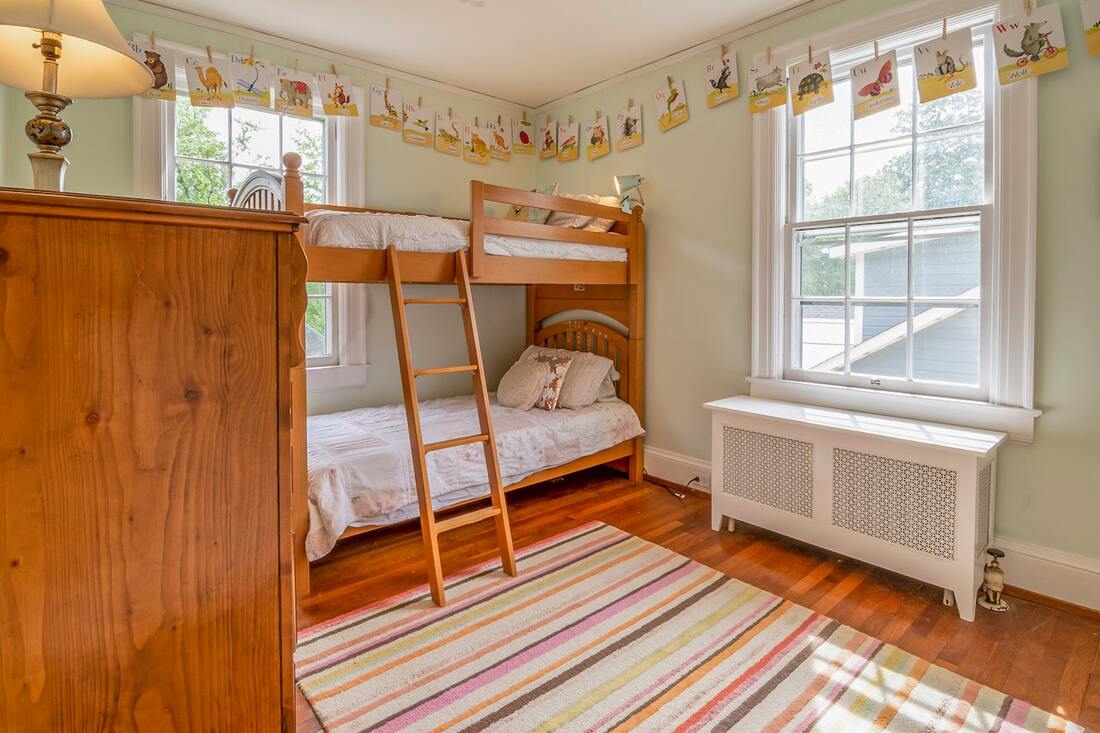|
Discover the secrets to navigating shared bedrooms after relocation! Learn tips for organization, personalization, and more. While sibling rivalry is a timeless saga, it takes on a new twist when brothers and sisters are asked to share the same bedroom, especially after a big move. That's where we step in! We’ll explore the world of navigating shared bedrooms after relocation, packed with tips, tricks, and ideas to help your kids sleep peacefully. The basics of navigating shared space Start by involving your kids in the rule-making process. Talk about boundaries – what's off-limits and what's fair game. Is it a no-fly zone for toys during study time? Are sleepovers allowed on school nights? By discussing and defining these rules together, you're teaching your children compromise and negotiation. Plus, posting the rules in a visible place is a friendly reminder when tempers flare. The essence of a harmonious shared bedroom lies in routine. Set designated times for different activities – study, play, and sleep – and involve your kids in this scheduling process. With your guidance, let them have a say in how they'd like to allocate their time. Creating a visual timetable with colorful markers can turn this into an exciting activity. Let them know that their voices matter and that you're there to listen and support them. Relocating with kids and settling in If you are wondering how to move with kids efficiently, talk to your children about the upcoming stage. You can relocate with your little ones easily if you work with movers and take the extra time to help your kids adjust. Explain why you're moving and highlight the positive aspects of the new home, such as a bigger backyard or proximity to a favorite park. Include your children in the packing and unpacking process. Let them help choose paint colors or decorations for their new, shared bedroom. This involvement empowers them and helps them feel a sense of ownership over their space. Try to recreate elements of their previous bedroom in the new one. Arrange their furniture in a similar layout and use familiar bedding and stuffed animals to provide comfort and a sense of continuity. Maintain regular routines as much as possible, especially bedtime routines. Consistency in daily activities helps children feel secure in their new surroundings. Make moving into their shared bedroom a special event. Ideas on how to divide the bedroom Transforming a shared bedroom into a harmonious haven often begins with creating distinct, individual spaces. One ingenious way to achieve this is by employing physical dividers or room partitions. These can be in the form of bookshelves, screens, or even curtains. Another strategy to divide and conquer shared bedrooms is strategically planning furniture placement. Opt for symmetrical layouts that create a visual balance in the room. When it comes to shared bedrooms, color can be a powerful tool in defining individual spaces. Work with your children to select a color scheme or theme for their respective sides of the room. Whether bold, vibrant colors or soothing pastels, the chosen palette can set the tone for each child's area. Decorate with bedding, curtains, and accessories that match their preferences while staying within the selected color scheme. Personalizing each side of the bedroom Shared bedrooms may be shared, but that doesn't mean individuality should take a back seat. Celebrating each child's unique personality and interests is the perfect opportunity. Encourage them to express themselves through their side of the bedroom. Let one sibling's side reflect their passion for art with an easel and a gallery wall of their creations. On the other side, create a cozy reading nook for the bookworm, with their favorite titles proudly displayed. Empower your children by involving them in decision-making when decorating their respective sides of the room. Provide them with furniture, colors, and decorations options, and let them choose what resonates most with their style. It's a chance for them to learn about their preferences and explore their creativity while contributing to the overall aesthetics of the shared bedroom. How to organize storage for siblings Assign each sibling their designated storage areas, making it clear where their toys, books, and personal items should go. Another key part of navigating shared bedrooms after relocation is labeling containers because it can make organization a breeze and help younger children easily identify their belongings. Consider under-bed storage drawers or wall-mounted shelves to maximize vertical space while keeping the floor clear for play and movement. A well-organized storage system keeps the room tidy and teaches kids valuable organizational skills. Shared storage in a bedroom offers an excellent opportunity to teach children about responsibility and organization. Make it a routine for them to clean up and put away their belongings before bedtime or at designated times during the day. Encourage them to take ownership of their space by involving them in the organization process. Teach them the importance of decluttering regularly and donating items they've outgrown. Maximizing space and functionality When it comes to shared bedrooms, the sky's the limit, quite literally! Lofted and bunk beds are magical space-saving solutions that instantly double the floor space available for activities. Bunk beds are practical and a source of adventure and camaraderie for siblings. Just imagine the joy of bedtime conversations and late-night giggles shared in the cozy confines of bunk beds. In shared bedrooms, every piece of furniture should pull double-duty. Look for multi-purpose pieces like beds with built-in storage drawers, ottomans that double as seating and toy storage, or desks that can be transformed into vanity tables. Wall-mounted fold-out desks and Murphy beds are also fantastic space-saving options. Additionally, consider furniture with adjustable components that can grow with your children, adapting to their changing needs and preferences. This versatile furniture maximizes space and promotes efficient organization and functionality. Creating zones for different activities A dedicated homework and study area is one of the ways to help young minds focus, learn, and excel. Set up a well-lit corner with a comfortable desk and ergonomic chair for each sibling. Ensure it's equipped with all the necessary supplies like pens, paper, and a lamp. Personalize these spaces with inspiring artwork or motivational quotes to encourage a positive study atmosphere. The play and recreation area is where the magic of imagination and bonding comes to life. Create a space where your children can unleash their creativity, whether building LEGO masterpieces, hosting impromptu puppet shows, or engaging in board games. Floor cushions, rugs, and low shelves with accessible toy storage bins make this area inviting and functional. Navigating shared bedrooms after relocation with our guide As we wrap up, we hope you've discovered the magic of turning sibling cohabitation into a harmonious adventure. Remember, the key is to celebrate differences while nurturing the sibling connection. Embrace the challenges of navigating shared bedrooms after relocation and watch your children create memories that will last a lifetime.
Photos via: Pexels Pexels Pexels Pexels |
To The Moon and Back Sleep ConsultingProviding families the tools & support they need to get their little ones sleeping through the night and napping like champs! Everyone has more fun when they are well rested! Visit Wollino - Discount Code: TOTHEMOONANDBACK10
Browse
All
|
All information provided on this website, including texts, images, and other materials, are for informational purposes only and should not be considered a replacement for assessment or treatment by a healthcare provider.
© COPYRIGHT 2016-2024 TO THE MOON AND BACK SLEEP CONSULTING. ALL RIGHTS RESERVED. WAKING GIRL WEB DESIGN
© COPYRIGHT 2016-2024 TO THE MOON AND BACK SLEEP CONSULTING. ALL RIGHTS RESERVED. WAKING GIRL WEB DESIGN










 RSS Feed
RSS Feed








